|
|
|
Sort Order |
|
|
|
Items / Page
|
|
|
|
|
|
|
| Srl | Item |
| 1 |
ID:
109759
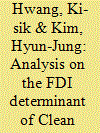

|
|
|
| 2 |
ID:
176751
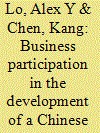

|
|
|
|
|
| Summary/Abstract |
Businesses are often involved in climate change governance and form networks to influence policy. They are evidently important for the implementation of market-based emission trading schemes and their general role has been widely discussed. However, there is a variety of business networks, and their specific structures and organizing styles are poorly understood, particularly in the non-Western context. This study identifies the ways in which one of these networks was organized and performed a governing function in the development of an emission trading scheme in China. We found that the policy development was neither highly top-down nor bottom-up, and business participation was hierarchical. Key governing roles were effectively performed by a small group of collaborating business organizations, which were essentially public-private hybrid actors and able to build linkages between the top and the bottom levels. The findings indicate the decisive qualitative differences in business leadership in the development of market-based policy.
|
|
|
|
|
|
|
|
|
|
|
|
|
|
|
|
| 3 |
ID:
116975


|
|
|
|
|
| Publication |
2012.
|
| Summary/Abstract |
Information on energy consumption and carbon dioxide (CO2) emissions from the iron and steel industry may become important to the assessment of energy saving and the design of emissions trading schemes. This paper focuses monitoring aspects, used two methods to calculate CO2 emission, the European Union Emission Trading Scheme and a method developed by the Japanese Iron and Steel Federation, to investigate the effect of the accounting method on the assessment of energy saving by four model steel mills with different levels of energy efficiency. Depending on the calculation method used, the calculated energy savings and calculated CO2 emissions for a given mill were found to differ from 5% to 15% and 4% to 14% respectively, simply by using different calculation methods. Methodologies that evaluate only CO2 emission and track emissions by process may not fully account for energy saving efforts such as using waste heat, generating power using byproduct gases, and energy management efforts applied over the whole mill rather than on a single process. Points of concern in the iron and steel industry are identified in the areas of calculating energy saving, determining CO2 emissions, and setting benchmarks.
|
|
|
|
|
|
|
|
|
|
|
|
|
|
|
|
| 4 |
ID:
124632


|
|
|
|
|
| Publication |
2013.
|
| Summary/Abstract |
For the post-Kyoto period, Turkey strongly emphasizes the establishment of national emission trading system by 2015 and its integration with the EU ETS along its accession process to the EU. In this paper, we study the mechanisms of adjustment and economic welfare consequences of various ETS regimes that Turkey considers to apply by 2020, i.e. regional ETS and international trading within the EU ETS. We conduct our analysis under the current EU 20-20-20 emission target, 20%, and also under its revised version, 30%. We find that Turkey has economic gains from linking with the EU ETS under the 20% cap, in comparison to the domestic ETSs. Despite the EU's welfare loss under linkage in comparison to the case where Turkey has domestic abatement efforts, it still prefers linking as it increases economic well being compared to the case where Turkey does not abate. Under 30% cutback, Turkey has critical output loss under linkage due to high abatement burden on the EU, while the EU is better off as it passes some of its abatement burden to Turkey. Therefore, emission quotas and their allocation across the ETS and non ETS sectors become highly critical in distributing the overall economic gains from bilateral trading.
|
|
|
|
|
|
|
|
|
|
|
|
|
|
|
|
| 5 |
ID:
119783
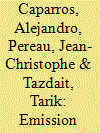

|
|
|
|
|
| Publication |
2013.
|
| Summary/Abstract |
Emission trading systems have been proposed in different regions to reduce polluting emissions and are in use in the European Union for carbon dioxide emissions. One of the objectives of these systems is to encourage firms to adopt advanced abatement technologies. However, permits also create an incentive to reduce output, which may be seen as negative by policy makers. We analyze the impact of a rigid labour market on these two outcomes, showing the conditions necessary to avoid reductions in production while keeping the incentives to improve abatement technologies. The analysis is done for oligopolistic firms engaged in international rivalry.
|
|
|
|
|
|
|
|
|
|
|
|
|
|
|
|
| 6 |
ID:
098708


|
|
|
|
|
| Publication |
2010.
|
| Summary/Abstract |
In order to step up its efforts in reducing climate change, the European Commission (hereafter: the Commission) has launched in June 2000 its European climate change program (hereafter: ECCP). This wide-ranging stakeholder consultation aimed at identifying and developing all elements necessary for a European climate change strategy. The ECCP formally came to a close in April 2003.
This paper analyses the inner workings of ECCP, and how ECCP has delivered with regard to its objectives. Special attention is paid to ECCP's Working Group 1, "Flexible Mechanisms", which developed the foundations for the European emission trading scheme (hereafter: EU ETS). The paper draws on documents published on the Commission's ECCP web-site, on academic literature, on press releases from stakeholders and on interviews with four participants in the ECCP process. Using this method, the paper offers important insights as to how the consensus-building for establishing the world's biggest carbon-trading scheme has started long time before the formal legislative process.
|
|
|
|
|
|
|
|
|
|
|
|
|
|
|
|
| 7 |
ID:
133312
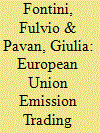

|
|
|
|
|
| Publication |
2014.
|
| Summary/Abstract |
We evaluate the contribution of technological change in reducing CO2 emissions in the Italian pulp and paper industry during the first and second phases of application of the European Union Emission Trading System (EU-ETS). We decompose the variation in emission and emission intensity into three different types of effects: a composition effect, a technique effect and a scale effect. The composition effect measures the change in emissions and emissions intensity due to a shift in production towards products that cause less emissions. The technique effect measures the change per each type of product, thereby accounting for technology improvements in the production of each type of good produced. The scale effect singles out the reduction in total emission due to an overall reduction in output. We show that the first phase of the application of EU-ETS has led to a reduction in both emissions and emission intensity due to the composition effect. The technological change has had a limited negative impact on emissions in the first phase, while in the second phase there has been limited technology improvement in the industry. However, the figures of the scale effect show that the larger reduction in emission is due to the overall decrease in output.
|
|
|
|
|
|
|
|
|
|
|
|
|
|
|
|
| 8 |
ID:
136204
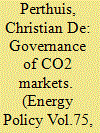

|
|
|
|
|
| Summary/Abstract |
The European emissions trading scheme (EU ETS) is the centerpiece of Europe׳s climate policy. The system has been undermined variously by the weakness of its regulation, an undesirable overlap with other public policies and the far-reaching economic and financial crisis that caused the market price of allowances to plunge. This article attempts to identify the conditions for making the coming years of the EU ETS a success. It draws historical lessons from the eight years the scheme has been in operation, and then presents the various interventions by the public authorities currently under discussion in order to revive the market. Finally, the article proposes to draw lessons from monetary policy by outlining what might be the mandate of an Independent Carbon Market Authority, with responsibility for the dynamic management of the supply of allowances, and whose main mission would be to ensure the optimal linkage between the different temporal horizons of the climate strategy. This article could provide important lessons for schemes developing in the rest of the world, especially in South Korea or in China.
|
|
|
|
|
|
|
|
|
|
|
|
|
|
|
|
| 9 |
ID:
156762


|
|
|
|
|
| Summary/Abstract |
Hong Kong continues to struggle over which environmental governance approach is in its best interest while fulfilling its environmental obligations. With regard to climate change, Hong Kong's approach is characterised by a passive form of governance that is highly dependent on China's national policy directions. This is reflected, for example, in Hong Kong having not set its own mitigation targets. Market mechanisms have received little attention in developing a city-wide climate change strategy. A transformative impulse, China's national emissions trading scheme, may provide momentum to a market-based approach. However, the necessary conditions for such a market mechanism to be successfully implemented in China remain relatively undeveloped. This raises question about early participation by Hong Kong. Direct benefits are likely to be limited, due to Hong Kong's economic structure and weak demand for emissions reduction. Besides, there are regulatory barriers to enforcing emissions targets and/or recognising emissions allowances and credits from China. We therefore argue that nationwide emissions trading may, at this time, present more challenges than opportunities for Hong Kong to leverage its efforts on climate change mitigation. An alternative is to promote voluntary emissions trading that will require active involvement and leadership by businesses.
|
|
|
|
|
|
|
|
|
|
|
|
|
|
|
|
| 10 |
ID:
180148


|
|
|
|
|
| Summary/Abstract |
To stabilize the global CO2 concentration in the long run and secure a net zero emission development path, low-carbon innovation is imperative. This paper evaluates the impact of emission trading schemes on low-carbon innovation. Particularly, we focus on the seven emission trading pilots in China. They employed diversified scheme designs, and reaping heterogeneous low-carbon innovation effects. The empirical results show that 1) low-carbon innovation in the three pilots of Beijing, Shanghai, and Guangdong responds more to the national demand for green technological changes, rather than to local policy shocks; 2) the Hubei pilot is the only successful one in raising low-carbon innovation motivations. Its success may be related to distinctive features of the market, including active transaction of carbon allowances, ambitious utilization of the auction mechanism in initial allowance allocation, and focus of regulation capacities on the most influential emitting entities. These features should be deliberately utilized in design the national carbon market, which has been pronounced at the end of 2017. Our research highlights the importance of detailed mechanism design for securing dynamic effectiveness of carbon emission trading schemes.
|
|
|
|
|
|
|
|
|
|
|
|
|
|
|
|
| 11 |
ID:
116702
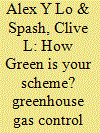

|
|
|
|
|
| Publication |
2012.
|
| Summary/Abstract |
Australia managed to pass a national carbon pricing scheme into legislation in November 2011, which has come into effect from July 2012. The scheme includes elements of a CO2-equivalent tax as a short prelude to emission trading. Several fundamental problems remain unaddressed, including: the continuing rise of emissions, the scale of growth and economic activity, the promotion of emission trading, subsidies to polluters, the hidden promotion of banking and finance sectors. The new policy appears primarily targeted at job creation and business as usual. We argue that the prospects for any meaningful reduction in emission levels are extremely unlikely.
|
|
|
|
|
|
|
|
|
|
|
|
|
|
|
|
| 12 |
ID:
114324


|
|
|
|
|
| Publication |
2012.
|
| Summary/Abstract |
Emission trading is considered to be a cost-effective environmental economic instrument for pollution control. However, the policy design of an emission trading program has a decisive impact on its performance. Allowance allocation is one of the most important policy design issues in emission trading, not only for equity but also for policy performance. In this research, an artificial market for sulfur dioxide (SO2) emission trading was constructed by applying an agent-based model. The performance of the Jiangsu SO2 emission trading market was examined under different allowance allocation methods and transaction costs. The results showed that the market efficiency of emission trading would be affected by the allocation methods when the transaction costs are positive. The auction allowance allocation method was more efficient and had the lowest total emission control costs than the other three allocation methods examined. However, the use of this method will require that power plants pay for all of their allowance, and doing so will increase the production costs of power plants. On the other hand, output-based allowance allocation is the second best method.
|
|
|
|
|
|
|
|
|
|
|
|
|
|
|
|
| 13 |
ID:
085412


|
|
|
|
|
| Publication |
2008.
|
| Summary/Abstract |
Seven years after the United States rejected binding emissions limitations and George Bush declared the Kyoto Protocol dead, there are signs of change. There is growing interest in emissions trading at the regional, national and substate level, and in the prospect of linking schemes together. This article suggests that the rapid growth of emissions trading markets themselves may be helping to swing the cost-benefit analysis of participation in emissions reduction commitments for American actors and others. Most simply, the practical viability of international emissions trading has now been confirmed, largely by the European market, but there are two further elements to this development for which this article presents the early evidence. Firstly, unanticipated benefits appear to be accruing in the established compliance markets. Secondly, ownership of the emerging markets can bring new bargaining power to encourage others to adopt meaningful climate targets.
|
|
|
|
|
|
|
|
|
|
|
|
|
|
|
|
| 14 |
ID:
125798


|
|
|
|
|
| Publication |
2013.
|
| Summary/Abstract |
Energy and climate policies are usually seen as measures to internalize externalities. However, as a side effect, the introduction of these policies redistributes wealth between consumers and producers, and within these groups. While redistribution is seldom the focus of the academic literature in energy economics, it plays a central role in public debates and policy decisions. This paper compares the distributional effects of two major electricity policies: support schemes for renewable energy sources, and CO2 pricing. We find that the redistribution effects of both policies are large, and they work in opposed directions. While renewables support transfers wealth from producers to consumers, carbon pricing does the opposite. More specifically, we show that moderate amounts of wind subsidies can increase consumer surplus, even if consumers bear the subsidy costs. CO2 pricing, in contrast, increases aggregated producer surplus, even without free allocation of emission allowances; however, not all types of producers benefit. These findings are derived from an analytical model of electricity markets, and a calibrated numerical model of Northwestern Europe. Our findings imply that if policy makers want to avoid large redistribution they might prefer a mix of policies, even if CO2 pricing alone is the first-best climate policy in terms of allocative efficiency.
|
|
|
|
|
|
|
|
|
|
|
|
|
|
|
|
| 15 |
ID:
136244


|
|
|
|
|
| Summary/Abstract |
The aim of this study is to analyze the effect that the Energy Tax Directive reform proposed in 2011 would have, if implemented, on the level of prices in the different sectors of the 27 countries of the European Union. We apply a multiregional and multisectoral model of trade flows that takes into account all the intersectoral and intercountry interdependences in the production processes. Using the World Input–Output Database we perform two different simulations. The first one considers the tax changes proposed by the reform; the second one shows the impact the reform would have entailed if it were applied also to sectors belonging to the European Trade System. The main finding of the first simulation shows that the new energy tax regime would have had a low economic cost in terms of impact on prices (less than 1% in all the countries). So, the concerns about competitiveness do not find empirical support in our results, suggesting the need for further analyses to find out the reasons that caused the failure of a reform that was an important step to introduce a taxation explicitly linked to CO2 emissions. The second simulation, however, leads to strongly different results, pointing out the relevance of maintaining significant economic incentives to reduce carbon emissions for the European Trade System sectors, by improving the emission market performance or by applying carbon taxation also to these sectors.
|
|
|
|
|
|
|
|
|
|
|
|
|
|
|
|
| 16 |
ID:
096116


|
|
|
|
|
| Publication |
2010.
|
| Summary/Abstract |
This paper presents a model-based approach, which allows to determine the optimised structure and operation of the EU-15 electricity supply under different political and economic framework conditions, with a focus on the integration of renewable energy sources for electricity generation (RES-E) in the EU-15 countries. The approach is designed to take into account the characteristics of power production from both renewable and conventional sources, including the technological and economic characteristics of existing plants as well as those of future capacity expansion options. Beyond that, fuel supply structures are modelled, as well as the international markets for power and CO2-certificates with their restrictions. Thus, a profound evaluation of the exploitation of mid-term renewable potentials and an assessment of the market penetration of the various renewable power generation technologies under the (normative) premise of a cost-optimised evolution of the power system becomes possible. Results show that a promotion of renewable energies reduces the scarcity of CO2-emission allowances and thus lowers marginal costs of CO2 reduction up to 30% in 2030. Despite the higher overall costs, a diversification of the energy resource base by RES-E use is observed, as primarily natural gas and nuclear fuels are replaced.
|
|
|
|
|
|
|
|
|
|
|
|
|
|
|
|
| 17 |
ID:
105816


|
|
|
|
|
| Publication |
2011.
|
| Summary/Abstract |
Emission trading programs (C&T) and renewable portfolio standards (RPS) are two common tools used by policymakers to control GHG emissions in the energy and other energy-intensive sectors. Little is known, however, as to the policy implications resulting from these concurrent regulations, especially given that their underlying policy goals and regulatory schemes are distinct. This paper applies both an analytical model and a computational model to examine the short-run implications of market interactions and policy redundancy. The analytical model is used to generate contestable hypotheses, while the numerical model is applied to consider more realistic market conditions. We have two central findings. First, lowering the CO2 C&T cap might penalize renewable units, and increasing the RPS level could sometimes benefit coal and oil and make natural gas units worse off. Second, making one policy more stringent would weaken the market incentive, which the other policy relies upon to attain its intended policy target.
|
|
|
|
|
|
|
|
|
|
|
|
|
|
|
|
|
|
|
|
|